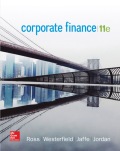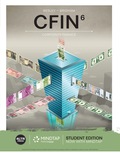
EBK CORPORATE FINANCE
11th Edition
ISBN: 8220102798878
Author: Ross
Publisher: YUZU
expand_more
expand_more
format_list_bulleted
Textbook Question
Chapter 16, Problem 20QP
MM Proposition I without Taxes Alpha Corporation and Beta Corporation are identical in every way except their capital structures. Alpha Corporation, an all-equity firm, has 18,000 shares of stock outstanding, currently worth $35 per share. Beta Corporation uses leverage in its capital structure. The market value of Beta’s debt is $85,000, and its cost of debt is 9 percent. Each firm is expected to have earnings before interest of $93,000 in perpetuity. Neither firm pays taxes. Assume that every investor can borrow at 9 percent per year.
- a. What is the value of Alpha Corporation?
- b. What is the value of Beta Corporation?
- c. What is the market value of Beta Corporation’s equity?
- d. How much will it cost to purchase 20 percent of each firm’s equity?
- e. Assuming each firm meets its earnings estimates, what will be the dollar return to each position in part (d) over the next year?
- f. Construct an investment strategy in which an investor purchases 20 percent of Alpha’s equity and replicates both the cost and dollar return of purchasing 20 percent of Beta’s equity.
- g. Is Alpha's equity more or less risky than Beta's equity? Explain.
Expert Solution & Answer
Trending nowThis is a popular solution!

Students have asked these similar questions
Scenario one: Under what circumstances would it be appropriate for a firm to use different cost of capital for its different operating divisions? If the overall firm WACC was used as the hurdle rate for all divisions, would the riskier division or the more conservative divisions tend to get most of the investment projects? Why? If you were to try to estimate the appropriate cost of capital for different divisions, what problems might you encounter? What are two techniques you could use to develop a rough estimate for each division’s cost of capital?
Scenario three: If a portfolio has a positive investment in every asset, can the expected return on a portfolio be greater than that of every asset in the portfolio? Can it be less than that of every asset in the portfolio? If you answer yes to one of both of these questions, explain and give an example for your answer(s).
Please Provide a Reference
Hello expert Give the answer please general accounting
Chapter 16 Solutions
EBK CORPORATE FINANCE
Ch. 16 - MM Assumptions List the three assumptions that lie...Ch. 16 - Prob. 2CQCh. 16 - Prob. 3CQCh. 16 - MM Propositions What is the quirk in the tax code...Ch. 16 - Prob. 5CQCh. 16 - Prob. 6CQCh. 16 - Optimal Capital Structure Is there an easily...Ch. 16 - Financial Leverage Why is the use of debt...Ch. 16 - Homemade Leverage What is homemade leverage?Ch. 16 - Capital Structure Goal What is the basic goal of...
Ch. 16 - Prob. 1QPCh. 16 - EBIT, Taxes, and Leverage Repeat p arts (a) and...Ch. 16 - ROE and Leverage Suppose the company in Problem 1...Ch. 16 - Break-Even EBIT Franklin Corporation is comparing...Ch. 16 - Prob. 5QPCh. 16 - Break-Even EBIT and Leverage Kolby Corp. is...Ch. 16 - Leverage and Stock Value Ignoring taxes in Problem...Ch. 16 - Homemade Leverage Star, Inc., a prominent consumer...Ch. 16 - Homemade Leverage and WACC ABC Co. and XYZ Co. are...Ch. 16 - MM Scarlett Corp. uses no debt. The weighted...Ch. 16 - Prob. 11QPCh. 16 - Calculating WACC Weston Industries has a...Ch. 16 - Prob. 13QPCh. 16 - MM and Taxes Bruce Co. expects its EBIT to be...Ch. 16 - MM and Taxes In Problem 14, what is the cost of...Ch. 16 - MM Proposition I Levered, Inc., and Unlevered,...Ch. 16 - MM Tool Manufacturing bas an expected EBIT of...Ch. 16 - Firm Value Cavo Corporation expects an EBIT of...Ch. 16 - MM Proposition I with Taxes The Dart Company is...Ch. 16 - MM Proposition I without Taxes Alpha Corporation...Ch. 16 - Cost of Capital Acetate, Inc., has equity with a...Ch. 16 - Homemade Leverage The Veblen Company and the...Ch. 16 - MM Propositions Locomotive Corporation is planning...Ch. 16 - Stock Value and Leverage Green Manufacturing,...Ch. 16 - Prob. 25QPCh. 16 - Prob. 26QPCh. 16 - Prob. 27QPCh. 16 - Prob. 28QPCh. 16 - Prob. 29QPCh. 16 - Prob. 30QPCh. 16 - STEPHENSON REAL ESTATE RECAPITALIZATION Stephenson...Ch. 16 - Prob. 2MCCh. 16 - Prob. 3MCCh. 16 - Prob. 4MCCh. 16 - Prob. 5MC
Knowledge Booster
Learn more about
Need a deep-dive on the concept behind this application? Look no further. Learn more about this topic, finance and related others by exploring similar questions and additional content below.Similar questions
- Scenario 2: The homepage for Coca-Cola Company can be found at coca-cola.com Links to an external site.. Locate the most recent annual report, which contains a balance sheet for the company. What is the book value of equity for Coca-Cola? The market value of a company is (# of shares of stock outstanding multiplied by the price per share). This information can be found at www.finance.yahoo.com Links to an external site., using the ticker symbol for Coca-Cola (KO). What is the market value of equity? Which number is more relevant to shareholders – the book value of equity or the market value of equity?arrow_forwardFILE HOME INSERT Calibri Paste Clipboard BIU Font A1 1 2 34 сл 5 6 Calculating interest rates - Excel PAGE LAYOUT FORMULAS DATA 11 Α΄ Α΄ % × fx A B C 4 17 REVIEW VIEW Alignment Number Conditional Format as Cell Cells Formatting Table Styles▾ Styles D E F G H Solve for the unknown interest rate in each of the following: Complete the following analysis. Do not hard code values in your calculations. All answers should be positive. 7 8 Present value Years Interest rate 9 10 11 SA SASA A $ 181 4 $ 335 18 $ 48,000 19 $ 40,353 25 12 13 14 15 16 $ SA SA SA A $ Future value 297 1,080 $ 185,382 $ 531,618arrow_forwardB B Canning Machine 2 Monster Beverage is considering purchasing a new canning machine. This machine costs $3,500,000 up front. Required return = 12.0% Year Cash Flow 0 $-3,500,000 1 $1,000,000 2 $1,200,000 3 $1,300,000 4 $900,000 What is the value of Year 3 cash flow discounted to the present? 5 $1,000,000 Enter a response then click Submit below $ 0 Submitarrow_forward
- Finances Income Statement Balance Sheet Finances Income Statement Balance Sheet Materia Income Statement Balance Sheet FY23 FY24 FY23 FY24 FY23 FY24 Sales Cost of Goods Sold 11,306,000,000 5,088,000,000 13,206,000,000 Current Current Assets 5,943,000,000 Other Expenses 4,523,000,000 5,283,000,000 Cash 211,000,000 328,600,000 Liabilities Accounts Payable 621,000,000 532,000,000 Depreciation 905,000,000 1,058,000,000 Accounts 502,000,000 619,600,000 Notes Payable 376,000,000 440,000,000 Earnings Before Int. & Tax 790,000,000 922,000,000 Receivable Interest Expense 453,000,000 530,000,000 Total Current Inventory 41,000,000 99,800,000 997,000,000 972,000,000 Taxable Income 337,000,000 392,000,000 Liabilities Taxes (25%) 84,250,000 98,000,000 Total Current 754,000,000 1,048,000,000 Long-Term Debt 16,529,000,000 17,383,500,000 Net Income Dividends 252,750,000 294,000,000 Assets 0 0 Fixed Assets Add. to Retained Earnings 252,750,000 294,000,000 Net Plant & 20,038,000,000 21,722,000,000…arrow_forwardDo you know what are Keith Gill's previous projects?arrow_forwardExplain why long-term bonds are subject to greater interest rate risk than short-term bonds with references or practical examples.arrow_forward
- What does it mean when a bond is referred to as a convertible bond? Would a convertible bond be more or less attractive to a bond holder than a non-convertible bond? Explain in detail with examples or academic references.arrow_forwardAlfa international paid $2.00 annual dividend on common stock and promises that the dividend will grow by 4% per year, if the stock’s market price for today is $20, what is required rate of return?arrow_forwardgive answer general accounting.arrow_forward
arrow_back_ios
SEE MORE QUESTIONS
arrow_forward_ios
Recommended textbooks for you
 Intermediate Financial Management (MindTap Course...FinanceISBN:9781337395083Author:Eugene F. Brigham, Phillip R. DavesPublisher:Cengage Learning
Intermediate Financial Management (MindTap Course...FinanceISBN:9781337395083Author:Eugene F. Brigham, Phillip R. DavesPublisher:Cengage Learning

Intermediate Financial Management (MindTap Course...
Finance
ISBN:9781337395083
Author:Eugene F. Brigham, Phillip R. Daves
Publisher:Cengage Learning

Financial ratio analysis; Author: The Finance Storyteller;https://www.youtube.com/watch?v=MTq7HuvoGck;License: Standard Youtube License